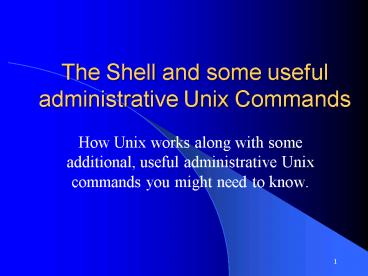The Shell and some useful administrative Unix Commands - PowerPoint PPT Presentation
1 / 15
Title:
The Shell and some useful administrative Unix Commands
Description:
UNIX Consistency. The version of the UNIX kernel that is used on a machine is determined by the ... Many of the same shells are found across all the versions of UNIX. ... – PowerPoint PPT presentation
Number of Views:96
Avg rating:3.0/5.0
Title: The Shell and some useful administrative Unix Commands
1
The Shell and some useful administrative Unix
Commands
- How Unix works along with some additional, useful
administrative Unix commands you might need to
know.
2
UNIX Consistency
- The version of the UNIX kernel that is used on a
machine is determined by the architecture of the
hardware. - Many of the same shells are found across all the
versions of UNIX. - All the versions of UNIX seem to be the same
due to the identical interface.
3
Shells
- Bourne shell (sh)
- Only shell guaranteed to be on every version of
UNIX - Probably the fastest shell due to its lack of
features - C - shell (csh)
- Uses C programming like syntax, but lacks a
strong I/O component which makes scripting hard. - Korn shell (ksh)
- Combines functionality of C-shell with the
scripting strength of Bourne shell. - T Shell (tcsh)
- Much better interface than C shell, but not
uniformly available across all UNIX. Is on
miller / grid - bash is also a popular shell
4
Shell Commands
- Command line UNIX is the most powerful interface,
but the most difficult to master. - Commands follow a general format
- command -options arguments
- command this is the actual command that you
are sending to the shell to be executed. - -options Options are also referred to as
flags. They are usually preceded with a minus
sign (-) Options modify the functionality of a
command. - arguments Used to tell the command what to
work with or what to work upon. - The spaces allow for the shell to parse the
command.
5
How the shell works
- Shell displays a prompt.
- Example for miller miller.cs
- Example for alpha ( alpha ) n
- where n is the number of commands so far.
- You type in a command.
- You press the return key.
- The shell interprets the commands you typed and
tries to find the correct programs to run. - The kernel runs the requested programs and
returns the results to the shell. - The shell displays the command prompt again.
6
Changing The Shell
- You can switch between which shell your using
relatively easy. - On miller / grid Simply type the shell that you
want to use. Example miller.cs tcsh - On alpha use the chsh command
- Example (alpha) 1 chsh
- Changing shell for SampleUser.
- Old shell /usr/local/bin/tcsh
- New shell csh
7
Standard Input, Output and Error
- Standard input
- stdin
- The place the program normally looks for input.
- The keyboard.
- Standard output
- stdout
- The place where the program normally sends its
output. - The screen.
- Standard error
- stderr
- Used by programs to display error messages.
- Also the screen.
8
Grouping commands
- Executing one command at at time can be tedious.
- Unix allows for grouping of commands by
separating commands with a semi-colon (). - Example miller.cs pwd cal 10 2003 date
9
(pipe)
- Used to link commands.
- command command etc.
- The output of the first command is sent as the
input to the second command, and so on, and so on
- Example miller.cs who more
10
Wildcards
- Typing in Unix can be tedious.
- Unix supports three wild-card characters
- Asterisk () matches any string of characters
including blanks. - Question mark (?) matches single characters.
- Square brackets () Tells the shell to match
any characters that appear inside the brackets.
11
Job control
- Unix works via jobs or processes.
- Every command or program is a separate process
executed by a user. - Processes are usually run in the foreground, but
can be made to run in the background. - Processes can be killed by the user who created
them.
12
Job control
- ctrl-c cancels a command/job
- Good for breaking out of infinite loops!
- ctrl-z suspends a command/job
- ps displays the status of current processes
- Example miller.cs ps
- PID TT S TIME COMMAND
- 3979 pts/131 S 000 -csh
- 5629 pts/131 S 000 tcsh
13
bg
- Forces a process to the background.
- First, type a ctrl-z to suspend the process.
- Then type bg and the process is forced to the
background. - Use the ps command to see it.
- You can force a process to the background
immediately with the .
14
fg
- Brings a process to the foreground.
- Use the ps command to see the processes you have
running. - Type fg number and that process will be
brought to the foreground.
15
kill
- Kills a process that you have running.
- Use the ps command to see what you have running.
- Type kill number.
- Not the most graceful way out, but it works.































